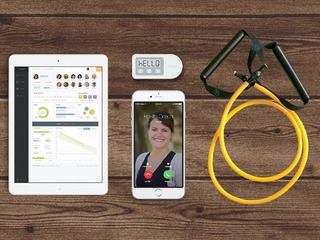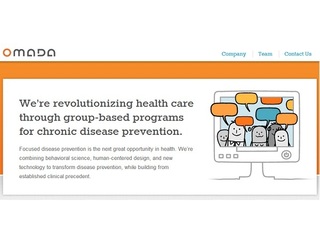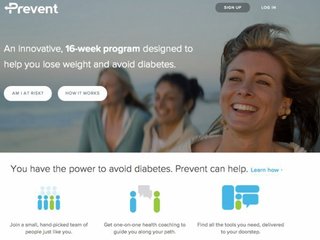Oxford Cancer Analytics raises $11M to detect lung cancer via a blood test
OXcan combines proteomics and artificial intelligence for early detection
Read more...
As healthcare expands beyond just the four walls of the doctor's office, digital therapeutics are on the rise: the global digital therapeutics market was valued at over $1.75 billion in 2017 and is projected to reach $7.8 billion by 2025.
Digital therapeutics are defined as software-driven evidence-based therapies that are designed to modify behavior. One of the pioneers in this space is Omada Health, a company that seeks to help prevent chronic types of disease by helping patients change their behavior and patterns using insights about social networking, gaming, and behavioral science.
On Thursday, the company announced an investment from Intermountain Ventures, the strategic investment arm of Intermountain Healthcare. This funding comes after Omada unveiled a $73 million round of funding led by Wellington Management Company LLP in June, and it brings the company's total capital raised to over $200 million.
Omada has been a partner with Intermountain Healthcare, a not-for-profit system of 24 hospitals, 215 clinics, and more than 2,500 physicians and clinicians in Utah, Idaho and Nevada, for the last five years. The Omada Program became a covered benefit for Intermountain employees and their adult dependents in 2019.
Founded in 2011, Omada Health contracts with organizations, who identify which of their employers are at the tipping point stage, where they are at risk of diabetes or heart disease, and then moves them into an intensive behavior counseling program.
Users are paired up with a health coach who guides them through different lifestyle changes. They also get weekly activities on nutrition and exercise that they can complete from a mobile device. Additionally, Omada mails participants a connected device, which can be a blood pressure monitor, a glucose meter or a wireless scale, that automatically syncs to their account. They also get access to weekly online lessons where they can explore physical, social, and psychological components of healthy living. They are also encouraged to connect with the Omada community who have similar health conditions for real-time encouragement, sharing, and support.
The program length varies depending on each person's unique health needs and goals, but it lasts at least one year.
Omada’s Chief Medical Officer, Dr. Carolyn Bradner Jasik, spoke to VatorNews about the partnership with Intermountain, how Omada's program is evolving and what areas the company plans to expand to going forward.
VatorNews: We’ve had Omada CEO Sean Duffy at our events before, but it would be great if you could give me an overview of where Omada is now. How do you position yourselves at this point?
Carolyn Bradner Jasik: Omada’s roots are in adapting scientifically proven behavioral change programming to a virtual setting to allow people to have increased access to really important services in chronic disease that are difficult to access currently. That can the diabetes prevention program, diabetes education, home blood pressure monitoring, cognitive behavioral therapy, all of these important programs that people have trouble accessing in the real world, we offer them in a virtual setting. We started initially in prediabetes and coined the term "digital therapeutics." The idea behind that was to take therapeutics, in this case a behavior change program that’s proven, and then digitize it.
Where Omada has evolved is we’re now talking more about digital care. What we’ve realized in the last few years is that people’s chronic conditions have a lot more crossover than we all realized, and think about, day to day. Depression co-occurs with obesity, and hypertension co-occurs with diabetes, so technology offers a really unique space in which we can address the whole person and a wider range of needs in one location in a new and interesting way. So, in creating these digital therapeutics and adapting these solutions to a virtual world, right now we’re trying to solve for and grow into treating the whole person at once and trying to blend these different solutions.
VN: How has the program itself evolved with that new line of thinking?
CBJ: The key components of the Omada program are being assigned a personal human coach with the proper credentials to work with you on whatever condition it is that you have, combined with smart home monitoring that is evidence-based and useful for whatever condition a person has, and then a tech infrastructure to deliver content and curriculum, also to support that condition.
What it means for us in a multi-condition world that we’re now working on is working with people with multiple devices at one time, and assigning them a team of coaches; everybody has a primary coach but having an extended team that brings expertise depending on the condition that the person has. And then really meeting the person where they’re at, depending on what they want to focus on. Traditionally, Omada would deliver a curriculum in a sequential way, based on the evidence and how the program had been designed, but now that we’re targeting more than one condition we’re allowing people to work through those programs at their own pace, choosing the topics that are of most interest to them. If they want to focus on blood pressure initially, they can focus on that. If they want to focus on their home glucose monitoring, but not necessarily address their weight right off the bat, then we do that. That’s the big difference now in terms of the participant journey is having more flexibility in the schedule and the content that they receive day to day.
VN: Talk to me about the partnership with Intermountain.
CBJ: Intermountain Healthcare, as an integrated delivery network, is an at-risk healthcare organization. So, they think about healthcare at a population level and take risk for the patients that they serve. Traditionally, in the U.S., organizations like Intermountain are often the most innovative in terms of care delivery because they’re incentivized to be that way. Because they have taken the financial risk for the patient, they often think out of the box and aren’t limited by traditional care delivery models as they exist in a fee for service environment. For example, integrated delivery networks are well known for care navigation, for having amazing clinical protocols, a wider range of team members and multidisciplinary care providers to really address the whole person.
That’s why a partnership for us with Intermountain is so great, because that's how we think about healthcare too. We think about it as we don’t want to be limited to a fee for service environment and the trappings of how billing and care is delivered. We want to be able to focus on the whole person and get them what they need at the right time. We also are willing to go at risk for that. So, just like Intermountain, we take risks for our patients in the sense that we do value-based payments. For our prediabetes program, if somebody doesn't lose weight in a particular month, or doesn’t use the program, we do not drop a charge; we only drop a fee based on how much weight the individual has actually lost. So, philosophically we’re really aligned with Intermountain in that way because we think the focus should be the patient and their outcomes, and not necessarily just providing care for care’s sake and get compensated for it.
VN: How does each side help the other in this partnership?
CBJ: This brings us to why it’s so great to work with on an investment with a health system for a company like Omada.
We have a lot of hard problems to solve in healthcare in terms of how to embed technology. As I was mentioning before, the incentives aren’t really aligned. If you’re a fee for service hospital, you obviously want the best for your patients, and you want them to have the best care, but, at the same time, most of your reimbursements come through the inpatient and ER settings. So, the nice thing about the partnership with Intermountain is, together, we can solve some of the problems with how we get these technology solutions into patient's hands, because most of the traditional care is incentivized for people to present in person because that’s when reimbursement occurs. Now, obviously, payers are changing and evolving their approach to this, but the partnership with Intermountain allows us to work directly with a healthcare delivery organization to start to think about we really embed these virtual services realistically alongside an in-person setting. We actually wrote a paper with the Intermountain doctors and the American Medical Association to talk about how to provide prediabetes virtual care in a traditional healthcare environment.
What we get out of the partnership is that we're not just a vendor that’s selling them a service, we’re really working together to make that service something that the larger healthcare ecosystem could take advantage of.
VN: The Omada Program became a covered benefit for Intermountain employees and their adult dependents in 2019. Prior to that, was it paid for out of pocket by employees? How did that work?
CBJ: This is a good question in terms of how companies like us work with health systems.
Traditionally, you’ll start with a pilot and we did that with Intermountain; we did a pilot with their patient population to confirm outcomes. An organization like Intermountain always wants to see that outcomes are being delivered and that the cost savings are there. After that pilot, we expanded the program to employees, so the employees now receive Omada as a covered benefit under Intermountain Healthcare, and the next step will be more broadly within Intermountain Health, to patients more broadly. That’s the evolution.
In terms of paying out of pocket, definitely, anybody can do Omada and pay for it out of pocket. We did actually notice that, in some cases, once the pilot ended for the Intermountain Providers, they had a limited number of slots and after those slots were utilized I did hear anecdotally that many of the Intermountain providers were recommending Omada to their patients on a self paid basis, and we do see that at other organizations as well.
VN: How many Intermountain employees and dependents now have access to Omada?
CBJ: Currently, all Intermountain employees and dependents have access to Omada as a covered benefit. We’ve had about 1,000 folks go through the program with us and we're seeing amazing results.
VN: Do you have any hard numbers about those results that you can share with me?
CBJ: Unfortunately, we didn’t get permission from Intermountain to share their employee results, but I can speak to our results more broadly, which is in our published papers. We see, on average, four percent weight loss at a year that’s sustained out to two years.
VN: What will the partnership with Intermountain look like going forward? How will it continue to evolve now that they are an investor?
CBJ: The next topic is expanding the program out to patients and looking into how that might work, and then also talking about some of our other programs and whether that would be a benefit.
More importantly than any of that, though, is having Intermountain working with us to learn and teaching us how to embed these programs within a care environment. So, topics like interoperability, getting data back to their providers, talking about how to facilitate referrals, how to identify eligible people for these programs using their population health database; these sound like small details but healthcare is so complex and so slow sometimes that if you’re not able to solve those small details it can be a real blocker for solutions like ours to be offered at scale. So, we’re grateful that Intermountain is willing to lift the covers there a little bit and help us solve some of those problems.
So, just to repeat: how do we identify eligible folks using EHR data? How do we refer them thoughtfully into programs like ours? And then what kind of data, and at what frequency, would those providers want to see that data back? You probably read a lot about interoperability and EHR integration, and that’s a nice buzzword, but when it comes to Monday morning in a primary care clinic, what kind of data do you really want to get from a company like Omada? And what’s really going to make a difference for your patient’s care? Having access to Intermountain’s physicians, and the partnership, to answer some of those questions is really helpful for Omada.
VN: What will you do with this new funding? Will it go toward expansion, hiring, product development?
CBJ: Kind of all of the above. We just raised a recent round of funding, and that funding round is really a growth round; it’s helping Omada expand into new product areas and boost our current products that are in the market, like diabetes, hypertension, depression and anxiety. It will expand and strengthen our commercial presence to get the word out about what we’re doing and hopefully generate new business in new sectors.
VN: What are some of those new product areas that you’d like to expand to?
CBJ: Healthcare delivery organizations, since we’re talking about Intermountain, is a big area. Trying to figure out what our potential partnership, from a financial perspective, looks like with a healthcare delivery organization, both one that’s at risk and also one that’s fee for service. That’s a really big goal.
The second piece is trying to think about new products in areas of chronic disease that are adjacent to what we already cover. For example, our cognitive behavioral therapy grew out of working with our participants initially with prediabetes and then diabetes and cardiovascular disease, and realizing what a barrier anxiety and depression are to behavioral change. So, we added those services to compliment our core programming and help people be even more successful. If you’re struggling with deep anxiety, it can be hard to be motivated in the morning to exercise or to make better choices about your nutrition or get to the doctor for your diabetes appointment or get expected labs for your cardiovascular disease. So, having that anxiety support really helps, and the new features we’re developing are complimentary features to support people with their core needs in chronic disease.
VN: What other sectors within healthcare are you looking to expand to next?
CBJ: A big area of focus for us is actually physical activity and fitness. That’s part of our core programming, so you might say, “Hey, that’s not new!” but it actually is, kind of. We’re starting to rethink how we address physical activity as a concept and as a goal for our participants, and really trying to personalize that more and more based on what people are struggling with. For Omada, we have leveraged more of a traditional approach to our physical activity education, but now we’re really starting to talk more with people about how chronic pain is a barrier to achieving physical activity, versus just trying to set goals around physical activity and problem solve access and interest and things like that. Chronic pain in particular as a barrier to physical activity is an internal focus that we’re really starting to talk to our participants about.
VN: Is there anything else that I should know about Omada, the funding or the partnership with Intermountain?
CBJ: I really think that 2020 is the year that digital health comes to maturity. There are several other companies out there that are having great success, both in the private and public markets, and are really becoming more embedded within healthcare. What I love about this Intermountain investment is that it really speaks to how digital health is more and more becoming less of an add-on, and more of an integral part of care. Investments like this, and partnerships with companies like Intermountain, are a signal that it’s no longer an extra, it’s really a piece, in several ways, of core clinical care that patients are getting. It’s really fun to see.
We’ve gone from, “Is there an app for that?” when the iPhone first came out and all these consumer healthcare apps, to digital delivery of care being a core part of what we do on a day to day basis in healthcare, not just in Omada but in the market in general. It’s a good time to be working in this area, it’s really fun to be part of it.
(Image source: omadahealth.com)
OXcan combines proteomics and artificial intelligence for early detection
Read more...Nearly $265B in claims are denied every year because of the way they're coded
Read more...Most expect to see revenue rise, while also embracing technologies like generative AI
Read more...Startup/Business
Joined Vator on
Omada Health is a Silicon Valley startup that is bringing the best in design and web technology to health care delivery. Omada's team is an interdisciplinary group of technologists, entrepreneurs and clinicians from Google, Amazon, IDEO, Harvard, Stanford and Columbia who are passionate about creating accessible technology to prevent disease.

Joined Vator on
Sean Duffy is the co-founder and CEO of Omada Health, a digital behavioral medicine company dedicated to inspiring and empowering people everywhere to live free of chronic conditions like heart disease and type 2 diabetes.



